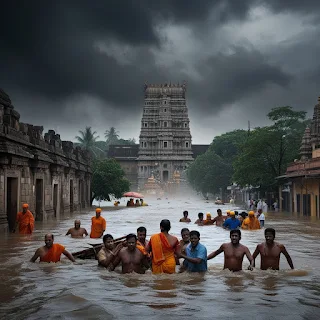Search This Blog
OMNI GYAN currently aims at providing video explanations to students belonging to MBOSE. It provides study materials, news on education, updates on all activities of the state education department. Omni Gyan also prepares students fully for their board exams. All Videos and Notes are for Classes 9 to 12.
Featured
- Get link
- X
- Other Apps
A RIVER (Class-10 Important Answers)
A RIVER BY A.K. RAMANUJAN
IMPORTANT QUESTIONS & ANSWERS
1. What city is described in the poem?
Answer: The city described is Madurai, known for its temples and poets.
2. What happens to the river in Madurai during summer?
Answer: During summer, the river dries up to a trickle, exposing sand ribs, straw, and women’s hair clogging the watergates.
3. How does the poet describe the dry riverbed?
Answer: The poet describes the dry riverbed as showing sand ribs, with wet stones glistening like sleepy crocodiles and dry stones resembling shaven water buffaloes lounging in the sun.
4. What do the poets of Madurai traditionally write about the river?
Answer: The poets of Madurai traditionally write about the floods but not about the river in its dry state.
5. What tragic events occurred during the floods mentioned in the poem?
Answer: During the floods, the river carried away three village houses, a pregnant woman, and two cows named Gopi and Brinda.
6. How does the speaker criticize the old poets?
Answer: The speaker criticizes the old poets for glorifying the floods but ignoring the human tragedy, such as the pregnant woman who drowned.
7. What does the speaker note about the "new poets"?
Answer: The speaker notes that the new poets still quote the old poets but fail to write about the human suffering, such as the pregnant woman drowning, in their verses.
8. What does the speaker imply about the poetic value of the river?
Answer: The speaker implies that the river is considered poetic only during the floods, not during its dry state, which reflects a limited and insensitive perspective.
9. How does the speaker describe the drowned pregnant woman?
Answer: The speaker describes the pregnant woman as possibly carrying twins, who were "kicking at blank walls even before birth."
10. What does the speaker's description of the twins' diapers symbolize?
Answer: The mention of "different coloured diapers to tell them apart" symbolizes the individuality and potential lives lost, making the tragedy more poignant and humanized.
11. What tone does the poet use to describe the old poets' approach to the river?
Answer: The tone is critical and ironic, highlighting the insensitivity of the old poets to the human suffering caused by the floods.
12. What is the overarching theme of the poem?
Answer: The overarching theme is the contrast between poetic glorification of nature and the neglect of human suffering and realities.
-----------------------------------------
If you find my contents helpful, then you can support here:
- Get link
- X
- Other Apps





Comments
Post a Comment